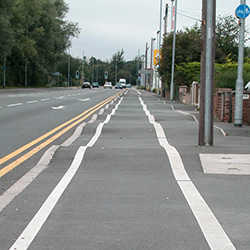Welcome to a comprehensive guide on enhancing safety and traffic control with speed bumps for asphalt. Speed bumps are a crucial tool in managing vehicle speeds and ensuring road safety. In this article, we will delve into the benefits of utilizing speed bumps, factors to consider during installation, proper installation techniques, and the effectiveness and controversies surrounding their use. Let’s explore how speed bumps on asphalt can play a significant role in creating safer roadways for both drivers and pedestrians.
What are Speed Bumps?
Speed bumps are traffic calming devices designed to reduce vehicle speeds in specific areas. They are typically raised sections of pavement placed across the roadway to slow down vehicles. The primary purpose of speed bumps is to enhance safety by controlling traffic flow and decreasing the speed of vehicles, particularly in areas where pedestrian safety is a concern. There are several types of speed bumps that serve varying purposes:- Humps: Rounded raised sections that span the width of the road
- Cushions: Similar to humps but with gaps in between to allow larger vehicles to pass more comfortably
- Speed Tables: Longer flat-topped structures that extend across the road, often used in areas requiring a more gradual speed reduction
Benefits of Speed Bumps for Asphalt
Speed bumps installed on asphalt roads offer numerous advantages that contribute to enhanced safety and better traffic control:- Accident Reduction: Studies have shown that the presence of speed bumps can lead to a significant decrease in accidents, especially in areas prone to speeding and reckless driving.
- Slower Vehicle Speeds: Speed bumps effectively force drivers to slow down, reducing the risk of collisions and providing a safer environment for both motorists and pedestrians.
- Enhanced Safety: By promoting reduced speeds, speed bumps help create a safer environment for drivers and pedestrians, particularly in high-traffic areas or near schools and residential zones.
Factors to Consider When Installing Speed Bumps
Installing speed bumps requires careful consideration of several factors to ensure their effectiveness in enhancing safety and traffic control:- Location: Choosing the right location for speed bumps is crucial. They are most effective in areas with high pedestrian traffic, near schools, or in residential zones.
- Size: The size of speed bumps plays a significant role in their effectiveness. They should be large enough to slow down vehicles but not cause discomfort to drivers.
- Spacing: Proper spacing between speed bumps is essential to maintain a consistent speed reduction. Too close together may lead to driver frustration, while too far apart can diminish their impact.
Proper Installation of Speed Bumps
Installing speed bumps in asphalt requires adherence to specific guidelines to ensure their effectiveness:- Preparation: Clear the area where the speed bumps will be installed, ensuring the surface is clean and free of debris.
- Placement: Mark the locations where the speed bumps will be placed, ensuring they are strategically positioned for maximum impact.
- Installation: Use proper equipment and materials to install the speed bumps securely in the asphalt, following manufacturer guidelines.
- Ensure the speed bumps are uniform in height and width to maintain consistency.
- Properly secure the speed bumps to prevent shifting or dislodging.
- Use reflective markings or signage to increase visibility for drivers.
- Inspect speed bumps periodically for wear and damage.
- Repair any cracks or damage promptly to prevent safety hazards.
- Reapply any necessary markings or signage to ensure visibility.
Effectiveness and Controversy of Speed Bumps
Speed bumps play a crucial role in controlling traffic speed and enhancing safety on roads. Here’s an overview of their effectiveness and the controversies surrounding their use:Effectiveness:
- Speed bumps effectively reduce vehicle speeds in areas where safety is a concern, such as near schools or residential areas.
- They help decrease the likelihood of accidents by forcing drivers to slow down and pay attention to their surroundings.
- Studies have shown that the presence of speed bumps can lead to a significant decrease in traffic-related injuries and fatalities.
Controversies:
Despite their benefits, speed bumps are not without controversy. Some common issues include:- Noise: The noise generated by vehicles passing over speed bumps can be a nuisance for residents living nearby.
- Impact on Emergency Vehicles: Speed bumps can potentially slow down emergency response times if not properly designed and located.
Potential Solutions:
To address the controversies surrounding speed bumps, consider implementing the following solutions:- Use alternative traffic calming measures, such as speed cushions or chicanes, to reduce noise levels while still controlling speeds.
- Work closely with emergency services to identify key routes where speed bumps may need to be modified or avoided to ensure quick access during emergencies.
Conclusion
In conclusion, speed bumps for asphalt are a valuable tool in enhancing safety and traffic control on roadways. By summarizing the main points covered in this article:- Speed bumps effectively reduce vehicle speeds and decrease the likelihood of accidents, especially in high-risk areas.
- Properly installed speed bumps can significantly improve safety for both drivers and pedestrians.
- Considering factors like location, size, and spacing is essential for the effectiveness of speed bumps.
- Despite controversies, solutions exist to address issues such as noise and impact on emergency vehicles.

